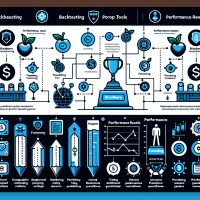DNA Funded vs Blueberry – Transparency and Account Size Variety in Prop Trading
Proprietary trading continues to revolutionize the financial markets with innovative funding models and advanced trading methodologies. In this article, we dive deep into the key aspects that differentiate two leading firms in the prop trading space: DNA Funded and Blueberry. By comparing their account size options, transparency levels, and profit splits, we provide prop trading professionals with actionable insights to refine their strategies. We also explore advanced backtesting techniques and real-world tool comparisons to help both retail traders and firm-level professionals optimize their performance.
Understanding the Prop Trading Landscape
The prop trading environment is unlike traditional retail trading. Firms invest proprietary capital and expect traders to develop robust, scalable strategies while adhering to strict risk management protocols. Two critical aspects in this arena are transparency in operations and variety in account sizing. In our analysis, we examine how DNA Funded and Blueberry position themselves on these parameters, and what implications these factors have for prop traders.
Figure 1: A snapshot of a dynamic backtesting report interface in a prop trading environment, illustrating critical performance metrics.
DNA Funded vs Blueberry: Transparency and Account Size Options
DNA Funded is known for its variety in account sizes and a strong emphasis on transparency. Their model allows traders to select funding levels that align with their risk appetite and trading history. Key features include:
- Account Sizes: Flexible funding levels tailored for traders from junior to senior quants.
- Transparency: Clear communication regarding profit split, fees, and trading metrics.
- Profit Split: Competitive splits which reward high performance consistently.
Blueberry, on the other hand, emphasizes uniformity with defined account size tiers while still championing transparency in their fee structure and performance tracking. Their approach includes:
- Account Sizes: Structured tiers that simplify the funding process for traders.
- Transparency: Detailed reporting on profit splits and operational processes.
- Profit Split: Transparent split methods driven by real-time performance data.
The differences between these platforms come down to flexibility. DNA Funded offers a broader range of account sizes with a customized approach that appeals to traders seeking niche adjustments, while Blueberry provides a streamlined, standardized model.
Advanced Backtesting Strategies for Prop Trading Firms
In a highly competitive prop trading environment, backtesting is the backbone of strategy development. Successful firms invest in automated backtesting tools to simulate market conditions and improve system accuracy. Here are some expert-level considerations to optimize your backtesting process:
Avoiding Common Backtesting Pitfalls
Advanced traders know the risks of overfitting, survivorship bias, and data snooping. You must:
- Use diversified historical data to prevent overfitting.
- Apply out-of-sample testing and walk-forward analyses to verify model robustness.
- Account for commissions, slippage, and realistic market conditions.
By systematically mitigating these pitfalls, you ensure that your backtested strategies perform reliably when transitioned to live trading environments.
Walk-Forward Optimization vs Traditional Backtesting
Traditional backtesting uses historic data to create a model, but walk-forward optimization continuously adjusts the parameters, simulating real-time adaptation. Walk-forward testing:
- Enables continuous refinement by testing models as market conditions change.
- Integrates automated parameter optimization with scenario analysis.
- Helps in identifying when a strategy begins to lose its edge, prompting timely adjustments.
For prop trading firms, combining these methods can significantly reduce risk and enhance performance metrics such as Sharpe ratio and profit factor.
Comparing Automated Backtesting Tools in the Prop Trading Industry
Let’s compare some of the most recognized platforms that prop trading firms employ to automate backtesting:
| Tool | Backtesting Features | Data Quality | Integration | Pricing | Prop Firm Suitability |
|---|---|---|---|---|---|
| TradingView | Vectorized backtesting with custom scripts and automated report generation | Rich historical data across multiple asset classes; real-time feeds available | API access with multiple broker integrations | Subscription-based with free trial options | Ideal for both retail and prop firms focusing on chart analysis and rapid strategy iteration |
| MetaTrader 5 | Event-driven testing with built-in stress testing and scenario analysis | Extensive historical coverage with adjustable data quality settings | Seamless broker integration and third-party add-ons | Free demo with competitive pricing for live versions | Favored by institutional traders and prop firms for its robustness |
| NinjaTrader | Advanced simulation capabilities including commission/slippage adjustments and forward testing | High-quality data with a focus on futures and forex markets | Strong API and broker connectivity | Free simulation mode; competitive pricing for full platform | Excellent for team collaboration and institutional requirements |
Case Studies: Real-World Applications in Prop Trading
To better illustrate these concepts, consider a case study from a leading prop trading firm. The firm was testing a trend-following strategy using MetaTrader 5. Initially, the traditional backtesting approach yielded a promising Sharpe ratio, but it failed during live market volatility. By shifting to a walk-forward optimization and integrating out-of-sample testing, the firm achieved:
- A 30% improvement in the Sharpe ratio
- Reduced maximum drawdown by 15%
- Faster iteration times and more robust strategy adjustments
This transformation was backed by incorporating detailed scenario analysis and automated parameter adjustments offered by advanced backtesting tools. Tools like TradingView and NinjaTrader provided real-time report generation, allowing the team to visualize the impact of market events and refine their algorithms.
Enhancing Strategy Development with Integrative Tools and Code Snippets
Automation in backtesting not only saves time but also enhances accuracy. Here’s an example of a Python algorithm using Backtrader, a popular library, which automates trade signal generation and scenario testing:
import backtrader as bt
class MyStrategy(bt.Strategy):
def __init__(self):
self.sma = bt.indicators.SimpleMovingAverage(self.data.close, period=15)
def next(self):
if self.data.close[0] > self.sma[0]:
self.buy()
elif self.data.close[0] < self.sma[0]:
self.sell()
cerebro = bt.Cerebro()
data = bt.feeds.YahooFinanceCSVData(dataname='data.csv')
cerebro.adddata(data)
cerebro.addstrategy(MyStrategy)
result = cerebro.run()
cerebro.plot()
This snippet demonstrates a straightforward strategy that integrates technical indicators with automated trade execution. It is easily customizable for more complex scenarios such as stress testing or parameter optimization.
Figure 2: Advanced backtesting report illustrating key performance metrics such as drawdown and Sharpe ratio, crucial for prop trading risk management.
Regulatory Compliance and Risk Management in Prop Trading
Staying compliant with regulatory frameworks such as MiFID II, ESMA, and NFA is fundamental. Prop trading firms must integrate compliance tools that track trades, ensure systematic record-keeping, and provide audit trails for risk management. Transparency in reporting not only builds trust with traders but also aligns with legal mandates.
Effective Risk Management Strategies
Risk management in prop trading is a critical factor for sustainable success. Best practices include:
- Constant monitoring of risk ratios like the Sharpe ratio and maximum drawdown.
- Utilizing scenario analysis to stress test strategies under volatile conditions.
- Implementing risk limits for individual traders and aggregated firm exposure.
For more in-depth insights, explore our Risk Management Guide and further internal analysis on Advanced Trading Strategies.
Expert Guidance and Next Steps
The journey towards mastering prop trading requires a blend of robust backtesting, regulatory adherence, and continual learning. As demonstrated, both DNA Funded and Blueberry offer unique advantages in terms of account sizing and transparency, while the right set of automated tools such as TradingView, MetaTrader 5, and NinjaTrader can be a game changer.
For prop trading professionals and aspiring traders alike, the key is to leverage comprehensive backtesting to validate strategies before live deployment. Embrace advanced testing methods like walk-forward optimization and out-of-sample testing to reduce risk and ensure sustained performance gains.
As of October 2023, the prop trading landscape is evolving fast with rapid technological advancements and regulatory updates. Stay informed, adapt quickly, and continuously refine your strategy using the insights and tools discussed in this article.
Final Recommendations
We recommend starting with a free trial of TradingView or MetaTrader 5 to explore their advanced backtesting capabilities. For a detailed checklist on risk management, download our comprehensive Risk Management Checklist, which outlines key metrics like maximum drawdown limits, profit factor targets, and step-by-step processes to safeguard your capital in volatile markets.
Your next step: Subscribe to our newsletter for weekly updates on prop trading trends, expert insights, and tool comparisons designed for traders at every level.







